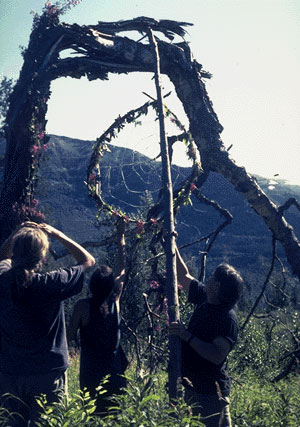ALASKA
Chugach National Forest

Bear Witness Circle. Twelve Children and
8 adults gathered in an immense clearcut near Homer to complete this circle.
In light rain they wrote blessing words on prayer flags torn from old sheets
found in the abandoned cabin at the edge of the ravaged forest. The children
planted baby spruce trees inside the circle formed by fern leaves and blackened,
splintered shards of wood. At the center of the circle was a life-size
bear mounded from living moss and lichen. We planted the "tree of life"
in the center of the red-cloth heart at the bear's center and buried meaningful
objects in the body of the animal. We set fire to the spruce pitch in the
bear's glass eye and each spoke aloud a word of hope in simple ceremony
around our creation: Resurrection, Transformation, Faith, Earth, Sun, Endurance,
etc. The forest will rise again. Never again will it be cut here.
The Chugach Indians called this vast, glaciated land in South-central
Alaska, the forest made from ice. Today, the Chugach National Forest, a
land of grand mountains, glaciers, islands and fjords, abundant wildlife
and fisheries, is clearly one of the world's most majestic intertidal ecosystems.
It is also the nation's second largest national forest and, relative to
others, perhaps the least impacted.While there has been some logging in
readily accessible areas of the forest, huge scale road-building and clearcutting
has not yet occurred. On the Kenai Peninsula, the western extent of the
Chugach, a massive spruce bark beetle outbreak has recently devastated
most of the forest there. A few scientists speculate years of fire control
may be the culprit in the outbreak. Others say beetles may indeed be a
natural cycle in a very mature, old growth forest. No one really knows.The
spruce-hemlock forests on the Chugach represent the northernmost temperate
rainforests in the world. At Alaskan latitudes, low solar insolation, long
winters and poor, unstable soils make forest regeneration a very slow process.
Clearcuts, like the one pictured above near Homer, take an exceptionally
long time to heal.

Dreamcatcher Zero. "This circle and another
below it that cannot be seen in this picture was built by a group of Prescott
College students to call attention to the web of life and the healing power
of the vortex. One could look through the hanging circle, the web of life
(grass woven into an alder frame and hung from a birch damaged and twisted
by heavy logging machinery) to another larger circle, the power vortex
below (rocks and flowers and charcoal from burn piles in the clearcut.)
The two circles speak of interconnectedness, of combining the energies
of activists into a web and vortex of power and protection. They speak,
also, of personal power. Whatever plans you have recently put in motion
are represented in the web of life and in the swirling fingers of fate
around you. For the forest, our own conscious, interconnected actions can
be powerful enough to counteract those who would seek to destroy the forest.
In this land made from ice, one is reminded of the healing power of time."
-- Glendon Brunk, Professor, Prescott College, Arizona.
This year, Congress has proposed over 60 anti-environmental riders,
11 of them by Alaska's delegation of Murkowski, Stevens, and Young. One
of the worst is the Chugach Road Rider. This would grant a 29 mile
easement across the Copper River Delta to Chugach Alaska Corporation
(CAC) to access their inholding. This road would cross over 200 salmon
streams and jeopardize the spawning grounds of the world renowned Copper
River salmon as well as the staging area for over 16 million shorebirds
annually.
To join efforts to protect Alaska's forests contact:
Prince of Wales Foundation: alan stein <alstein@ricochet.net
Alaska Center for the Environment, 519 West 8th, Suite 201, Anchorage,
AK 99501, 907-274-3621.
Home
Gallery

